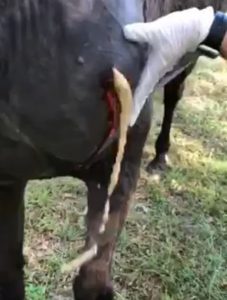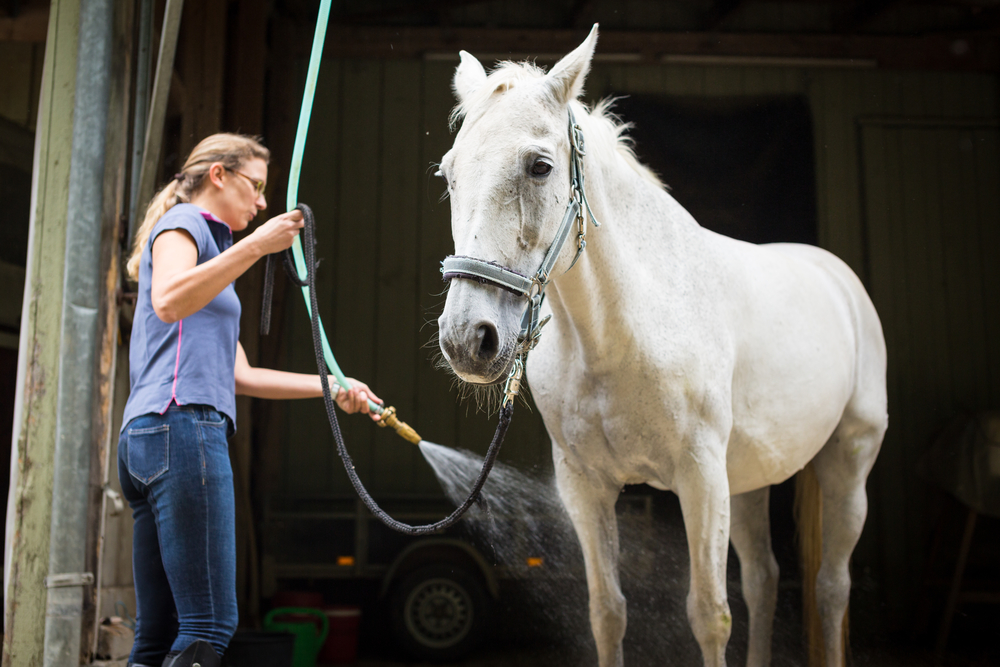Tuesdays with Tony
Proper Wound Care
Pus. I’m not going to lie: we have an unnatural reaction to pus around here. Especially large quantities of pus. The excitement when there’s a lot of pus potential is palpable. Phones come out with cameras at the ready, everyone gathers round, and the moment the scalpel nears the area, the crowd goes silent. I’m going to let you in on a little secret about why all this excitement happens the way it does: 99.9% of the time the horse is going to be OK, and so my Docs can revel in the joy of all that pus, while knowing that with a few simple care instructions this wound is going to heal.
Why all that pus?
 Let’s start with why there’s all that pus in the first place. Pus is a collection of dead fighters from the immune system (these are cells called neutrophils, lymphocytes, and mast cells), along with some serum (the liquid part of blood), and dead invaders. There’s a couple of reasons the body makes buckets of pus. The first is that the bacteria involved cause the immune system to really send in the troops. This is common with bacteria in the genus Streptococci in particular, and these guys live on normal skin, so they are around when wounds happen.
Let’s start with why there’s all that pus in the first place. Pus is a collection of dead fighters from the immune system (these are cells called neutrophils, lymphocytes, and mast cells), along with some serum (the liquid part of blood), and dead invaders. There’s a couple of reasons the body makes buckets of pus. The first is that the bacteria involved cause the immune system to really send in the troops. This is common with bacteria in the genus Streptococci in particular, and these guys live on normal skin, so they are around when wounds happen.
The second is a foreign body. Pieces of wood are a favorite foreign body for horses. Wood can be a fun combination of reason one and two since all those nooks and crannies in wood can hide a lot of bacteria. The third reason is that the body can’t overcome the infection, and keeps sending more and more immune system cells.
Minimizing pus
I have learned, in my years supervising here at the Clinic, that not every human feels the same excitement about pus as my Docs. In an effort to assist with this pus disdain, let’s talk about how to minimize pus production. It starts with a simple saying that I get rather tired of hearing from Dr. Lacher: Dilution is the solution to pollution. She means you’re going to get to spend a lot of time with a hose pointed at your horse’s wound. When a wound happens, all kinds of bacteria take advantage of the situation to invade. The body responds with white blood cells, and Voila! Pus. By gently rinsing a wound, you send those bacteria on their merry way to go wreak havoc elsewhere.
Wise Cat Tip: If the wound is actively bleeding, don’t start rinsing quite yet. Wise Cat Tip #2: Take a picture with your phone, and send it to my Docs. This lets them help you make decisions about proper care. Turns out you can use that phone for more than taking pictures of cats, and looking at pictures of cats, and watching cat videos. Who knew?
After hosing the wound for a good 10 minutes, apply an antibacterial ointment like triple antibiotic ointment. Do not go with whatever crazy goop you have laying around. Nearly all of the random lotions, potions, and ointments you have laying around are actually bad for wounds. My rule is if the Docs didn’t tell me to put something else on there, then triple antibiotic it is. As you know, cat rules are the highest rules of the land. They must be followed.

Keeping it clean
This is something I can really relate to, as a self-bathing creature. I like things clean. However, this doesn’t mean scrub a wound within an inch of its life. Gently cleaning with minimal soap once daily is all that’s needed. After soap, guess what? Run water over that wound for at least 10 minutes. After that, some triple antibiotic. If possible, a bandage, or even better, Sox for Horses covering a wound, which will help it heal significantly faster.
The bad news: horses love to cause injury to themselves. The good news: they do like to heal those wounds. With a little time, TLC, and water, most wounds will heal up great.
Now be a good human and subscribe to my blog below.
Your Fearless Feline Leader,
Tony
P.S. Want even more great horse knowledge? Tune in to the podcast the humans do called Straight from the Horse Doctor’s Mouth.
Tuesdays with Tony is the official blog of Tony the Clinic Cat at Springhill Equine Veterinary Clinic in Newberry, Florida. If you liked this blog, please subscribe below, and share it with your friends on social media! For more information, please call us at (352) 472-1620, visit our website at SpringhillEquine.com, or follow us on Facebook!
[jetpack_subscription_form title=”Subscribe to Tuesdays with Tony”]
